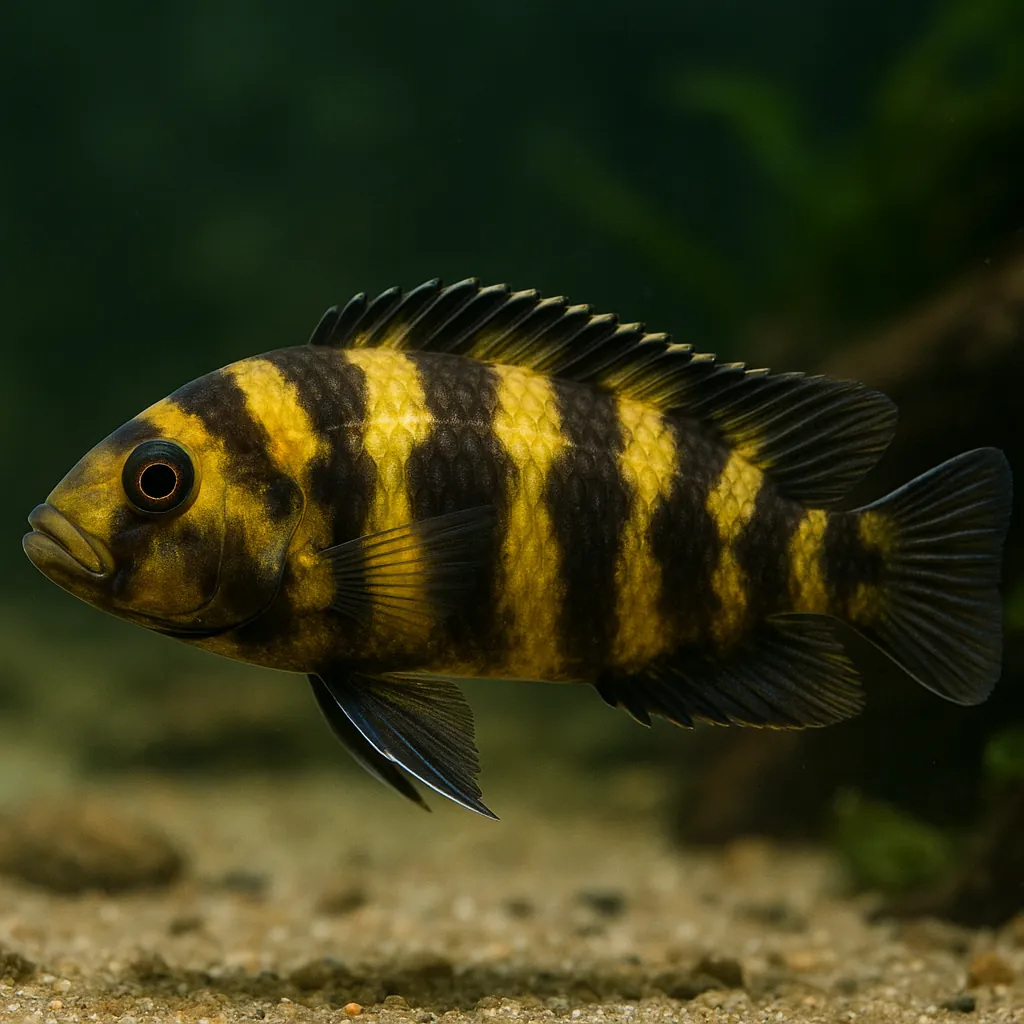
Bumble bee cichlid
Introduction
The Bumblebee Cichlid (Pseudotropheus crabro), also known as the Hornet Cichlid, is a vibrant and dynamic freshwater fish native to Lake Malawi in Africa. Its striking yellow and black striped pattern, reminiscent of a bumblebee, makes it a popular choice among aquarists. While their captivating appearance is appealing, Bumblebee Cichlids are known for their territorial and aggressive behavior, requiring careful consideration and management in home aquariums.
What makes the Bumblebee Cichlid a popular choice for aquarists?
Their distinctive coloration and active behavior add visual interest and liveliness to aquariums, attracting hobbyists seeking vibrant and engaging fish.
Are Bumblebee Cichlids suitable for beginner fishkeepers?
Due to their aggressive nature and specific care requirements, they are better suited for aquarists with some experience in managing territorial fish species.
Care and Environment
Proper care for Bumblebee Cichlids involves replicating their natural habitat and addressing their specific needs to ensure a healthy and harmonious aquarium environment.
What is the minimum tank size for a single Bumblebee Cichlid?
A minimum tank size of 120 liters is recommended for a single Bumblebee Cichlid to provide adequate space and reduce territorial aggression.
What are the ideal water parameters for Bumblebee Cichlids?
Maintain a temperature between 24°C and 28°C, a pH level of 7.8 to 8.6, and water hardness of 10-20 dGH to mimic their native Lake Malawi conditions.
How should the tank be decorated to suit Bumblebee Cichlids?
Incorporate a sandy substrate with ample rock formations and caves to provide hiding spots and establish territories, reducing aggression among tank inhabitants.
What is the recommended diet for Bumblebee Cichlids?
Offer a balanced diet consisting of high-quality pellets or flakes supplemented with live or frozen foods like brine shrimp and bloodworms, along with occasional vegetable matter such as spinach or spirulina.
How can aggression be managed in a tank with Bumblebee Cichlids?
Provide sufficient space, establish clear territories with decorations, and avoid housing multiple males together to minimize aggressive interactions.
Origin and Habitat
Bumblebee Cichlids are endemic to Lake Malawi in East Africa, predominantly inhabiting large caves and areas with substantial boulder formations. They are often found at depths of 15-18 meters, sharing their environment with species like the Kampango Catfish (Bagrus meridionalis). The lake's clear, hard, and alkaline waters, along with its rocky substrates, provide an ideal habitat for these cichlids.
What type of environment do Bumblebee Cichlids prefer in the wild?
They thrive in rocky habitats with numerous caves and crevices, which offer shelter and breeding sites.
How does their natural habitat influence their behavior?
The abundance of hiding spots and territorial spaces in their native environment contributes to their aggressive and territorial nature.
Temperament and Compatibility
Bumblebee Cichlids are known for their aggressive and territorial behavior, especially during breeding periods. They are best kept with other robust mbuna species that can withstand their assertive nature. Suitable tank mates include species like the Yellow Lab (Labidochromis caeruleus) and the Acei Cichlid (Pseudotropheus acei). It's advisable to avoid housing them with smaller, more docile fish or species with similar coloration to prevent aggression.
Can Bumblebee Cichlids be kept with other fish?
Yes, but they should be housed with similarly sized and temperamentally compatible mbuna species to minimize conflicts.
How can aggression be minimized in a community tank?
Providing ample space, creating distinct territories with decorations, and maintaining a proper male-to-female ratio can help reduce aggression.
Interesting Facts
Bumblebee Cichlids exhibit a fascinating ability to change their coloration rapidly, especially during interactions with the Kampango Catfish. In their natural habitat, they act as cleaner fish, feeding on parasites from larger fish. However, they have also been observed preying on the eggs of the Kampango Catfish, changing their color to a dark brown while doing so to avoid detection.
Why are they called Bumblebee Cichlids?
Their yellow and black striped pattern resembles that of a bumblebee, leading to their common name.
Do Bumblebee Cichlids have any unique behaviors?
Yes, their rapid color-changing ability and dual role as both cleaner fish and opportunistic egg predators are particularly notable behaviors.
Sources
All information in this article has been gathered from the following reputable sources:
Overview
Recommended Tank Size 52.8 Gallons (for groups of 6 or more) |
Minimum Group Size 1 |
Minimum Tank Volume 31.7 Gallons |
Maximum Adult Length 6.3 inches |
Average Adult Length 5.9 inches |
Shoaling (6+ required) No |
Preferred Water Type Hard, alkaline freshwater |
Temperature Range (°C) 24-28 |
pH Range 7.8-8.6 |
Water Hardness (dGH) 10-20 |
Typical Lifespan (years) 8 years |